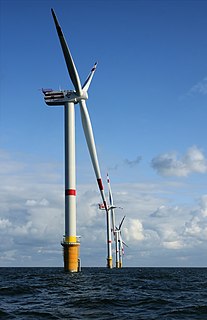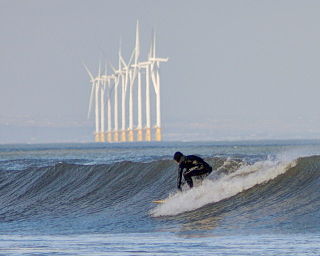
Wind power or wind energy is the use of wind to provide the mechanical power through wind turbines to turn electric generators and traditionally to do other work, like milling or pumping. Wind power is a sustainable and renewable energy, and has a much smaller impact on the environment compared to burning fossil fuels.

A wind farm or wind park, also called a wind power station or wind power plant, is a group of wind turbines in the same location used to produce electricity. Wind farms vary in size from a small number of turbines to several hundred wind turbines covering an extensive area. Wind farms can be either onshore or offshore.

The Tehachapi Pass wind farm is one of the first large-scale wind farms installed in the U.S., with around 710 megawatts (950,000 hp) produced by about 3400 wind turbines.

Wind power in Scotland is the fastest-growing renewable energy technology, with 8423 MW of installed wind power capacity as of December 2018. This included 7800 MW from onshore wind in Scotland and 623 MW of offshore wind generators.

Wind power in Ohio has a long history, and as of 2016, Ohio had 545 megawatts (MW) of utility-scale wind power installations installed, responsible for 1.1% of in-state electricity generated. Over 1000 MW more were under construction or pending approval. Some installations have become tourist attractions. There has been a sudden increase in generating capacity, as total wind power capacity in the state was just 9.7 MW in 2010. By 2019, there were 738 MW of capacity, which generated 1.71% of Ohio's electricity.

Biglow Canyon Wind Farm is an electricity generating wind farm facility in Sherman County, Oregon, United States. It is owned by Portland, Oregon based Portland General Electric and began operations in 2007. With the completion of phase 3 of the project it has a generating capacity of 450 megawatts. It is located roughly five miles (8 km) northeast of Wasco, Oregon, and about ten miles (16 km) southeast of Rufus, Oregon. Biglow Canyon Wind Farm covers 25,000 acres (10,000 ha) in the Columbia River Gorge.
Specialized wind energy software applications aid in the development and operation of wind farms.

The Fowler Ridge Wind Farm is a wind farm in Benton County, Indiana, near the city of Fowler, IN about 30 miles (48 km) northwest of Lafayette and 90 miles (140 km) northwest of Indianapolis. Fowler Ridge was originally developed in 2005 and 2006 by Orion Energy, LLC and Vision Energy, LLC and later sold in 2007 to BP and Dominion Resources. The project was constructed beginning in 2008 in two phases and has a nameplate capacity of 600 MW.
The wind power industry is involved with the design, manufacture, construction, and maintenance of wind turbines. The modern wind power industry began in 1979 with the serial production of wind turbines by Danish manufacturers. The industry is currently undergoing a period of rapid globalization and consolidation.

Community wind projects are locally owned by farmers, investors, businesses, schools, utilities, or other public or private entities who utilize wind energy to support and reduce energy costs to the local community. The key feature is that local community members have a significant, direct financial stake in the project beyond land lease payments and tax revenue. Projects may be used for on-site power or to generate wholesale power for sale, usually on a commercial-scale greater than 100 kW.

The environmental impact of wind power is relatively minor when compared to that of fossil fuel power. Compared with other low-carbon power sources, wind turbines have one of the lowest global warming potentials per unit of electrical energy generated by any power source. According to the IPCC, in assessments of the life-cycle global warming potential of energy sources, wind turbines have a median value of between 15 and 11 depending on whether offshore or onshore turbines are being assessed.

A wind turbine, or alternatively referred to as a wind energy converter, is a device that converts the wind's kinetic energy into electrical energy.

Offshore wind power or offshore wind energy is the use of wind farms constructed in bodies of water, usually in the ocean, to harvest wind energy to generate electricity. Higher wind speeds are available offshore compared to on land, so offshore wind power’s electricity generation is higher per amount of capacity installed, and NIMBY opposition to construction is usually much weaker.
Wind turbine syndrome and wind farm syndrome are terms for adverse human health effects that have been ascribed to the proximity of wind turbines. Proponents have claimed that these effects include, congenital abnormality, cancer, and death. The distribution of recorded events, however, correlates with media coverage of wind farm syndrome itself, and not with the presence or absence of wind farms. Neither term is recognised by any international disease classification system, nor do they appear in any title or abstract in the United States National Library of Medicine's PubMed database. Wind turbine syndrome has been characterized as pseudoscience.
GE Wind Energy is a branch of GE Renewable Energy, a subsidiary of General Electric. The company manufactures and sells wind turbines to the international market. In 2018, GE was the fourth largest wind turbine manufacturer in the world.

As of 2016, Arizona has 268 megawatts (MW) of wind powered electricity generating capacity, producing 0.5% of in-state generated electricity.

Teesside Wind Farm, or alternatively referred to as Redcar Wind Farm, is a 27 turbine 62 MW capacity offshore wind farm constructed just to the east of the mouth of the River Tees and 1.5 km north of Redcar off the North Yorkshire coast, in the North Sea, England.

The great majority of wind turbines around the world belong to individuals or corporations who use them to generate electric power or to perform mechanical work. As such, wind turbines are primarily designed to be working devices. However, the large size and height above surroundings of modern industrial wind turbines, combined with their moving rotors, often makes them among the most conspicuous objects in their areas. A few localities have exploited the attention-getting nature of wind turbines by placing them on public display, either with visitor centers on their bases, or with viewing areas farther away. The wind turbines themselves are generally of conventional horizontal-axis, three-bladed design, and generate power to feed electrical grids, but they also serve the unconventional roles of technology demonstration, public relations, and education.

Wind power in Hawaii has the potential to provide all of the electricity generation in the electricity sector in Hawaii. The 114 commercial wind turbines in the state have a total capacity of 206 MW. In 2015, wind turbines produced 6.4% of Hawaii's electricity. In 2017, sources of renewable power were: In 2012, Hawaii generated 367 million kWh from wind power.

Block Island Wind Farm is the first commercial offshore wind farm in the United States, located 3.8 miles (6.1 km) from Block Island, Rhode Island in the Atlantic Ocean. The five-turbine, 30 MW project was developed by Deepwater Wind. Construction began in 2015 and in late summer 2016 five Alstom Haliade 150-6-MW turbines were erected. Operations were launched in December 2016. It is the largest project using wind power in Rhode Island.

















